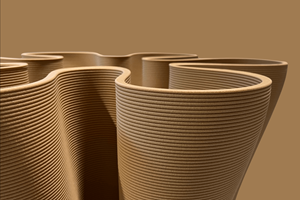IMDEA Materials Institute helps create intelligent sensors for aviation composites
As a part of the European Union’s DOMMINIO project, IMDEA Materials Institute is helping to create embedded smart sensors via 3D printing to provide real-time updates on aircraft during flight.

IMDEA Materials Institute (Madrid, Spain) is playing a key role in the development of next-generation aircraft sensor technology which will enable real-time monitoring of airframe components in flight. Such smart sensors, designed to be embedded within the parts themselves, are set to provide benefits in both cost and safety to the airline industry in the coming years (learn more about sensors in composites).
This, at least, is one of the goals of the European Union-funded Digital Method for Improved Manufacturing of Next-Generation Multifunctional Airframe Parts (DOMMINIO) project. One of IMDEA Materials’ roles within this international research consortium is in carrying out the advanced simulation and experimental work required to develop the sensor technology, and in the creation of high-fidelity virtual models known as digital twins.
“They are called digital twins because they are very accurate digital models that are updated during the whole life cycle, replicating the physical part or component within the aircraft in real time,” IMDEA Materials researcher Moisés Zarzoso explains. “Through its embedded sensor, the physical part is able to communicate directly with engineers on the ground. If, for example, you had an impact during flight from hailstones, information relating to any possible damage to the part would be recorded by that sensor and then sent automatically to its digital twin. Using that information, the simulations that we are developing will be able to analyze the risk that a potential impact could induce in the structural integrity of the component, and to determine its remaining lifespan.”
This research is being conducted via the Institute’s Structural Composites group led by Professor Carlos González. The role of simulation and modeling work in the development of sensors are said to enable researchers to push the boundaries of materials characterization.
“In order to design the sensor, we have to be able to characterize it,” Zarzoso says. “We can do this through experiments, but also with simulations. With simulations, you can go further in some aspects. You can study the effects of certain design parameters that would either be impossible, or extremely expensive, to test experimentally.”
“If you could have a new way of designing and manufacturing these aircraft, that could give you real-time information from sensors about the structural health of the airframe, you could improve the maintenance process.”
Crucially, IMDEA Materials Institute notes that the technology being developed through the DOMMINIO project would not only enable real-time monitoring it would also implement advanced 3D printing techniques and advances in the production of carbon fiber nanotube (CNT) to embed the sensor within the part during manufacture, rather than attach them post-production, reducing the amount of electrical cabling required to power the current generation of aircraft sensors. This, in turn, could see aircraft become more fuel efficient and thus more environmentally friendly and cheaper to fly for operators.
Also involved in the DOMMINIO project is IMDEA Materials’ Multifunctional Nanocomposites group, led by Dr. Juan Jose Vilatela, which has taken on the role of developing the CNT sensor and experimental analysis of its piezoresistive properties when embedded in the component.
“The sensors are being designed to be made from these fibers, which are incredibly light compared to existing materials and which also consume very little energy,” Zarzoso explains. “They are also 3D-printable and, given that they are CNT fibers, they can be easily embedded into a component manufactured from traditional carbon fiber, which is a very common material in aircraft production.”
The benefits of this technology, however, go beyond weight reduction. It will also permit airlines to adopt more efficient and effective maintenance programs.
“Aircraft maintenance is programmed, after a pre-determined amount of flight hours, you have to stop the plane flying to check the various parts and components,” Zarzoso says. “If you could have a new way of designing and manufacturing these aircraft, that could give you real-time information from sensors about the structural health of the airframe, you could improve the maintenance process. This would result in significant time and cost savings for the airlines while adhering to the demanding safety standards for aircraft.”
The DOMMINIO project is funded by the European Union through the Horizon 2020 research and innovation program.
Along with IMDEA Materials Institute, collaborators in the project include coordinators AIMEN Technological Centre (Galicia, Spain) aerospace giant BAE Systems (Farnborough, U.K.) and Spanish aeronautical firm Aciturri (Burgos, Spain), the National Technical University of Athens (Greece) and the French-based Arts et Métiers Institute of Technology and Industrial Center for Plastics and Composites (IPC).
Also part of the consortium are the National Institute for Aerospace Research “Elie Carafoli,” (BucureÈ™ti, Romania), Tortech nano-Fibers Ltd. (Ma’alot Tarshiha, Israel), DASEL Systems (Madrid), Innovation in Research & Engineering Solutions (IRES) consultants, ESI Group (Rungis, France) and the European Aeronautics Science Network (EASN).
Related Content
Combining multifunctional thermoplastic composites, additive manufacturing for next-gen airframe structures
The DOMMINIO project combines AFP with 3D printed gyroid cores, embedded SHM sensors and smart materials for induction-driven disassembly of parts at end of life.
Read MoreSulapac introduces Sulapac Flow 1.7 to replace PLA, ABS and PP in FDM, FGF
Available as filament and granules for extrusion, new wood composite matches properties yet is compostable, eliminates microplastics and reduces carbon footprint.
Read MoreLarge-format AM speeds plug production for manufacture of composite boat molds
Hungarian manufacturer Rapid Prototyping transitioned its conventional foam milling process to 3D printing to produce faster, higher quality, recyclable foam plugs and composite boat molds.
Read MoreIndustrializing additive manufacturing in the defense/aerospace sector
GA-ASI demonstrates a path forward for the use of additive technologies for composite tooling, flight-qualified parts.
Read MoreRead Next
Ceramic matrix composites: Faster, cheaper, higher temperature
New players proliferate, increasing CMC materials and manufacturing capacity, novel processes and automation to meet demand for higher part volumes and performance.
Read MoreCutting 100 pounds, certification time for the X-59 nose cone
Swift Engineering used HyperX software to remove 100 pounds from 38-foot graphite/epoxy cored nose cone for X-59 supersonic aircraft.
Read MoreScaling up, optimizing the flax fiber composite camper
Greenlander’s Sherpa RV cab, which is largely constructed from flax fiber/bio-epoxy sandwich panels, nears commercial production readiness and next-generation scale-up.
Read More












